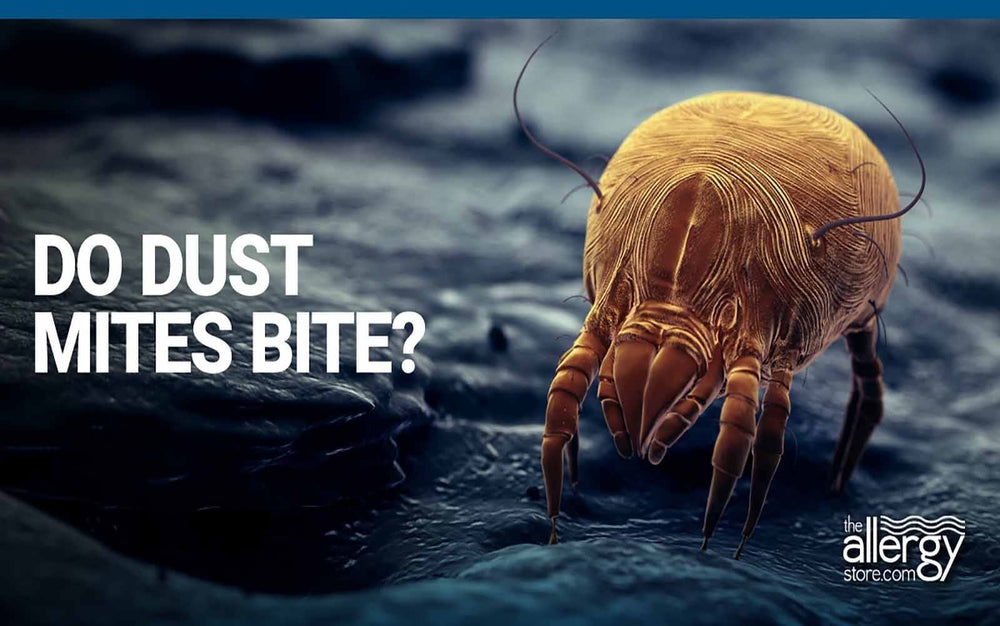
We get calls from people who have woken up tired with raised bumps and itchy skin, think they have been bitten, and want to know if dust mites can bite.
The short answer to the question, “Do/dust mites bite?” is NO!
Not only do dust mites not bite, but dust mites can’t bite. They aren’t made that way.
Dust Mite Anatomy – Why Dust Mites Can’t Bite You
Dust mites are 1/100th of an inch in size. Dust mites are scavengers by nature. They feed on tiny scales of shed skin. Their eating parts are not like ours. A dust mite doesn’t have a head. It has a body part known as a gnathosoma. It’s a fusion of the topmost body part, legs, and the chelicerae.
The chelicerae are the cutting, piercing, and grasping parts. They are too small, dull, and weak to remove skin from a living host. That’s why they must be scavengers.
So, as you see, they don’t have a conventional head, mouth, or teeth. That’s why dust mites can not bite you.
That is not to say that there are no bugs that can get in your bed and bite at night, but the symptoms will differ.
Bed Bugs Do Bite
If you have bed bugs, the key difference is that bed bugs bite humans and feed off of their blood. They leave a small bump that can itch intensely.
Bed bugs are larger than dust mites and can be seen with the naked eye. They’re sometimes confused with dust mites because they live in bedding, carpets, and curtains. And like dust mites, they can also cause allergic reactions.
Bed bug bites tend to occur in rows of two or three. Also, if a bug is biting you in bed, you will find specks of blood on the sheets. If you’ve got bug bites, don’t blame dust mites. They can’t bite you.
So now you ask, if they don’t bite and I don’t have bed bugs, what is it, and why don’t I feel like I slept?
Dust Mite Allergy
Misidentified proteins cause allergy. In the case of dust mite allergy, the troublesome protein is Der p1 from the gut. The fecal pellets and body parts contain this protein. Your immune system thinks this harmless protein is a germ.
So, you inhale the protein, and your immune system gets to work. Your mast cells get all excited. You produce histamine. Histamine is an inflammatory agent. It’s germ warfare against a germ that doesn’t exist. It’s an allergic reaction.
Dust Mite Allergy Symptoms
Itching, sneezing, watery eyes, and wheezing are symptoms of dust mite allergy. Allergic urticaria, also known as hives, is a symptom.
These are itchy, small red bumps or wheals that may look like bug bites. While bug bites are singular, the bumps from hives will be in groups. Hives are a rash.
Do you have trouble thinking clearly in the morning? Do you feel like you are in a fog for a couple of hours after you get up? You might have a dust mite allergy.
Dust mite allergy symptoms are worse in the morning. That’s because your bedroom is the favorite spot for dust mites.
Dust mites love dark, warm, slightly damp places with plenty of food. That describes your bed. All night, you sleep with dust mites. So, you feel terrible when you get up.
Now What?
Just because dust mites can’t bite you doesn’t mean you should tolerate them. You can
You can visit an allergist for a skin or blood test to determine if you have a dust mite allergy. Be sure to let the doctor’s office know if you are taking any over-the-counter or prescribed medications that can interfere with the test. For example, all antihistamines must be stopped well in advance of testing.
Special Note: Testing a room for dust mites wastes time and energy. They are common, and if people sleep in a room, it will have dust mites. Instead of focusing on identification, focus on reducing allergen levels is essential.
The most commonly recommended first step is to encase the mattress, box spring, and pillows in special zippered dust mite covers impervious to dust mites and dust mite allergens.
In addition, dust-catching knick-knacks should be removed from the room, and the sheets, pillows, and blankets should be washed weekly in 140°F water. If you want additional information, follow our guide on how to kill dust mites to fight the mites.
Dust mites can make you miserable, but they can’t bite you.
Till next time,
Cheryl

